Author: bms
When Circle rings the bell at Nasdaq in June 2025, the large-scale adoption of stablecoins will finally shed the "proof of concept" label and gain real capital market coordinates. As Circle CEO Jeremy Allaire stated at TOKEN 2049: "We are moving towards a world where assets flow as seamlessly as sending an email, without chains or borders." However, today's multi-chain environment still resembles the gateway of the dial-up internet era: developers patching compatibility across various chains, while users jump repeatedly between wallets, networks, and gas fees. Web3 assets urgently need an infrastructure upgrade akin to cloud-native for Web2—encapsulating underlying complexity into a unified abstraction layer, allowing application innovation to no longer be constrained by chain boundaries. The friction caused by multi-chain asset issuance and application needs to be thoroughly eliminated.
I. Why Web3 Assets Need a "Superconductor" Connecting Multiple Chains
In the past two years, the explosive growth of Layer 2 and application chains has made on-chain assets seem to "bloom everywhere," but for end users, the challenges faced by Web3 assets in cross-chain financial topologies are not merely transfer delays, but a set of overlapping systemic issues:
1. Capital-Level "Multiple Constraints"
If institutional capital pools want to deploy simultaneously across networks like Ethereum, Berachain, and Sonic, they must repeatedly undergo the cycle of "locking → minting → unlocking → reminting"; each state migration is exposed to gray rhino risks such as bridge contract reentrancy, beacon delays, and finality issues.
From a compliance perspective, the situation is even sharper: when a stablecoin or securitized asset traverses multiple chains and jurisdictions, it often needs to satisfy KYC/AML reporting for both "source of funds" and "destination of funds" simultaneously. If a business or individual fails to report in sync, they risk having their assets frozen or facing money laundering charges. Additionally, some countries require that when offshore on-chain assets return to the domestic market, they must be re-entered into the local capital account.
2. User Experience and Developer "Protocol Vision Obscurity"
For end users, the sequence of "transaction signing → network switching → gas calculation → waiting for confirmation" essentially exposes the internal complexity of the protocol; once cross-chain, users must also grapple with additional information noise such as "mapped token discounts, bridge liquidity depth, oracle timeliness," etc. The result is that fund composability is fragmented, and inter-chain friction rates surge.
Developers face "three-way coupling damping," where calling multi-chain liquidity requires manual handling of asynchronous gas fee replenishment, flash loan rollback boundaries, and Merkle proof depth differences; even with the help of universal bridges, they must constantly monitor router reordering and sequencer congestion.
Due to differing security models, contract call paths present the paradox of "shortest logical stack ≠ lowest trust stack": what seems like a simple exchange between two chains is actually extended to N + 1 potential attack surfaces.
II. The Path to Reducing Friction for Web3 Assets in the Multi-Chain Era
Currently, the industry has formed three approaches around "allowing assets to be issued and used anywhere," each targeting different aspects of inter-chain friction:
Everclear focuses on "net intent"—it uses a Netting Solver to offset excess paths locally, helping institutions reduce rebalancing and hedging costs when deploying across multiple networks.
Particle Network starts from account abstraction, unifying identities, signatures, and authorizations from different chains into a single interface with a Universal Account, eliminating the mental burden of users switching wallets and networks back and forth.
One Balance emphasizes real-time portfolio management and lightweight cross-chain exchanges, aggregating tokens, LP positions, and NFTs from various chains into a single total asset view, with built-in native routing supporting small-scale chain swaps. Each has its strengths, but all still rely to varying degrees on underlying bridging or decentralized liquidity.
Recently, Cycle Network, incubated by Yzi Labs and led by Vertex Ventures under Temasek, has chosen to dig one layer deeper: through Verifiable State Aggregation, it aggregates multi-chain states into a unified secure consensus, allowing "settlement finality" and "liquidity depth" to converge simultaneously, providing a cloud-native-like abstract foundation for upper-layer applications to freely call upon the aforementioned three types and more innovations.
III. What is Cycle Network
3.1 Innovative Multi-Chain Settlement Layer
Cycle Network is a "multi-chain settlement layer" designed to eliminate multi-chain friction. Through its self-developed Verifiable State Aggregation technology and Symbiotic security consensus, it aggregates the states of over 20 networks, including Ethereum, BNB Chain, Arbitrum, Berachain, and Monad, into a unified settlement surface, allowing users and developers to call upon cross-chain assets without relying on traditional cross-chain bridges. 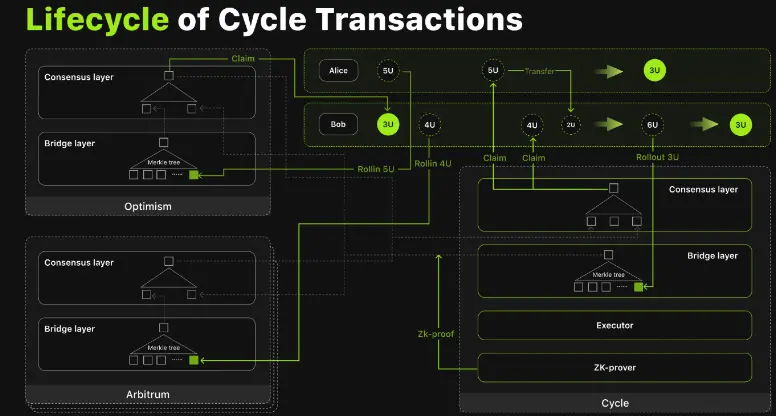
3.2 Core Advantages of Cycle Network
The core advantage of Cycle Network lies in "hiding" the complex cross-chain process within the underlying protocol: leveraging Verifiable State Aggregation and Rollin/Rollout APIs, users only need to sign once to complete asset transfers within any dApp, without needing to understand bridges, network switching, or gas tokens, thus eliminating cognitive and operational barriers of traditional cross-chain processes.
At the same time, Cycle abstracts ETH, BTC, stablecoins, and even RWA assets across EVM and non-EVM chains into the same liquidity pool through a unified settlement layer and liquidity routing, enabling free calls of any asset on any chain, allowing developers to combine multi-chain assets as easily as calling an API interface.
In simple terms, Cycle has built a gate at the confluence of multiple rivers—water flow no longer entangles at the source; just lift the gate, and the assets flow down smoothly.
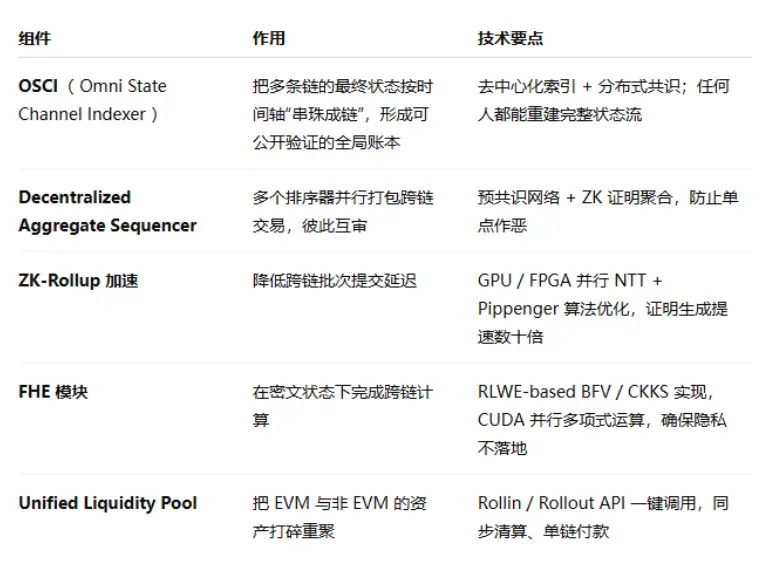

3.3 Product Deep Dive: Simultaneous Efforts for B-end and C-end
B-end Developer's Boon: Rapid Deployment of Chain Abstraction SDK
For developers, Cycle Network has launched the Cycle SDK, essentially a toolkit that encapsulates Verifiable State Aggregation capabilities into an easy-to-access development suite. Developers only need to introduce the Rollin/Rollout module in their contracts or servers to upgrade a single-chain application into a truly chain-abstracted DApp within ≤ 1 day, without needing to manually write bridging logic or maintain multiple front-end network switches. The SDK includes automatic liquidity routing, unified gas estimation, and Symbiotic shared security verification, while also opening Webhook and Subgraph for real-time monitoring and risk control of multi-chain transactions in the background.
Practical application scenarios include:
Decentralized Exchange (DEX): Utilizing the SDK's aggregated liquidity to conduct cross-ecosystem trades like ETH — BNB and BTC — wBERA in the same matching pool; user trading paths are indistinguishable from single-chain experiences, yet automatically split into multiple chain liquidity sources in the background.
Cross-Chain Lending Platform: Developers can use Rollout to collateralize assets on one chain and borrow stablecoins on another, with all collateral value and liquidation logic unified and verified by the Cycle settlement layer → significantly reducing liquidation delays and price difference risks.
On-Chain Games: Game studios only need to integrate the SDK once to allow players to purchase Bera chain NFT items with SOL or settle gas fees with USDC, with players perceiving it as "direct payment," while the complex multi-chain processes are completed in the background.
The Popular "Goose Raising" Mini-Game on TikTok: Golden Goose
Golden Goose is the most representative C-end DeFAI application in the Cycle ecosystem: it turns "chain abstraction + gamification" into a tangible revenue entry, allowing Web 2 users to earn on-chain returns with a single click, without needing to switch networks or prepare gas. The platform is divided into Game Mode and Pro Mode: the former packages revenue strategies into a goose-raising game, combining an NFT growth system with a cyclical reinvestment mechanism; the latter integrates structured strategies such as stable interest rate spreads, LP mining, and lending arbitrage to provide returns.

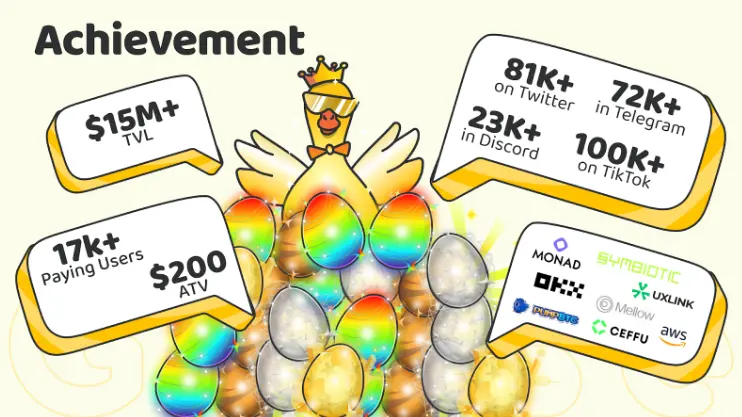
On TikTok, some describe Golden Goose as an automatic dividend "on-chain vending machine": you just need to drop a "start" button, and the intricate cross-chain gears quietly turn behind the scenes, packaging liquidity and strategies from multiple chains into yield eggs that roll out to you—without needing to understand wallets or switch networks, just collect the money. (Note: be aware of risks)
IV. Driving On-Chain Assets: Cycle Network's Value Positioning in Stablecoins and RWA
4.1 Why Stablecoins and RWA Have Become Global Focuses
Demand for Hedging and Liquidity: With increasing global macro volatility, fiat currency inflation, and capital controls, the market has a strong need for USD-denominated, on-chain real-time settlement assets. According to the latest data from Coingecko, the circulating market value of stablecoins has surpassed $250 billion.
Acceleration of Asset Digitization: Regulatory sandboxes and on-chain settlement pilots are continuously being implemented, with Real-World Assets such as real estate, accounts receivable, and government bonds seen as the most certain track for blockchain implementation.
Cost and Transparency Advantages: On-chain transfers and settlements have average transaction fees an order of magnitude lower than traditional cross-border systems, while programmability provides instant verifiable underlying data for auditing and compliance.
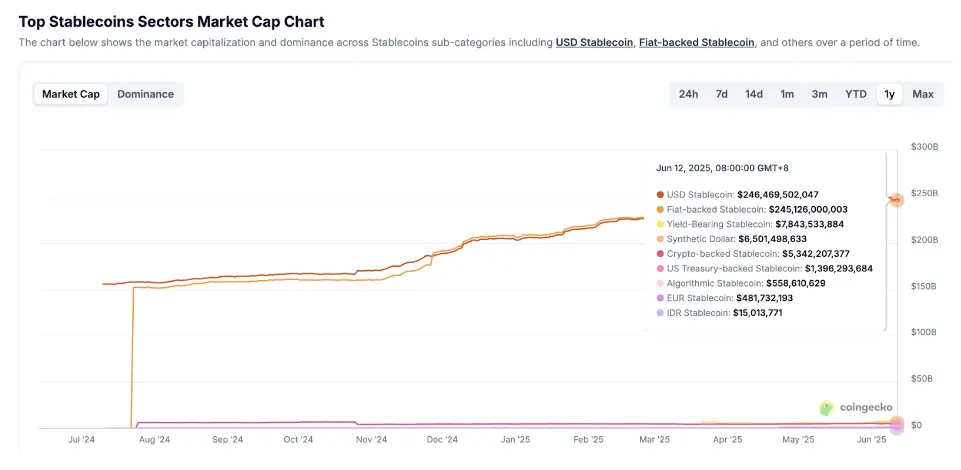
4.2 How Cycle's Multi-Chain Settlement Mechanism Becomes Infrastructure for Stablecoins and RWA?

4.3 From Past "Fringe Experiments" to Concrete Application Scenarios
Multi-chain stablecoin clearing gateway: Issuers can mint USDC on Chain A and map the equivalent assets to Chain B without bridges through the Cycle settlement layer, completing merchant payments with zero slippage. For users, the payment path is no different from traditional card payments.
RWA secondary market matching: Suppose tokenized government bonds are issued on the OP Stack chain, institutional market makers can manage positions on Berachain and quote on Arbitrum, with the underlying net settlement completed by Cycle, avoiding price difference risks caused by bridge delays.
Cross-border payroll/supply chain settlement: Companies can pay salaries in stablecoins in LATAM, while suppliers can instantly convert to local fiat in SEA, saving over 50% in fees and 1-2 business days in settlement time compared to traditional SWIFT through Cycle's automatic path optimization and batch netting.
4.4 Cycle's Long-Term Impact on the Sector
Cost curve downward shift: The marginal cost of multi-chain issuance and settlement approaches zero, significantly lowering the issuance threshold for RWA.
Increased liquidity depth: Unified liquidity routing reduces fragmentation, allowing stablecoins and RWA to serve as collateral or payment mediums on more chains.
Improved compliance bridges: Standardized APIs and verifiable state proofs provide real-time data interfaces for auditing agencies and regulators, accelerating the formation of compliance frameworks.
V. Growth Leverage and Ecological Flywheel: A Business Perspective on Cycle
5.1 Quantifying Opportunities: From "Niche DeFi" to "Trillion-Dollar Real Assets"
DeFi user base: According to DeFiLlama's 2025 data, there are fewer than 20 million active wallets across all chains; if multi-chain barriers are completely eliminated, referencing the penetration curve of mobile payments from early trials to widespread adoption, an exponential expansion to 100 million – 150 million in five years is not exaggerated.
Stablecoin market: The latest total market cap has exceeded USD 250 billion; if the annual scale of global cross-border payments is USD 150 trillion (McKinsey, 2024), even a 1% migration on-chain would represent USD 1.5 trillion in liquidated flow for the settlement network.
RWA potential: A BCG report predicts that the scale of on-chain real assets could reach USD 16 trillion by 2030; these assets require a secure, low-friction cross-chain liquidity layer.
5.2 Revenue Structure: Multi-Source Cash Flow Rather Than Single-Point Games
C-end: For instance, Golden Goose has generated over USD 200,000 in internal purchases and strategy sharing in the first two quarters of 2025; as daily active users and reinvestment rates continue to rise, this growth curve is the most rapid.
B-end: The Cycle SDK adopts a hybrid model of subscription + transaction commission; once more DApps entrust settlement to Cycle, SDK fees and customized enterprise services will bring predictable annual revenue.
Infrastructure: Although the inter-chain settlement fees for Rollin/Rollout start low, as over 20 chains connect simultaneously and daily cross-chain volumes increase to tens of millions or even billions, its "infrastructure tax" will become the most robust cash flow.
Key points: The revenue side presents a three-tier progression of C-end consumption (quick money) + B-end subscriptions (stable money) + infrastructure taxation (long tail), avoiding reliance on a single blockbuster or airdrop hype.
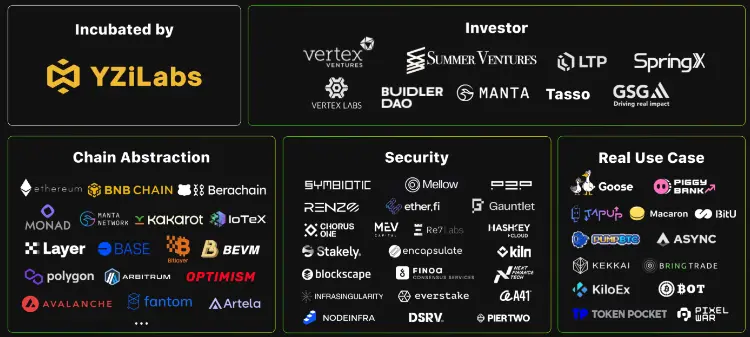
5.3 User Funnel: Guiding Web2 Naturally to On-Chain
Cycle is not "just another cross-chain bridge," but rather makes the logic of cross-chain bridges an invisible public foundation, naturally becoming a lever for overlaying traffic entry.
When the promotion side first achieves exposure through TikTok and X videos, it then guides the audience into the site with a "wallet installation" landing page. Subsequently, one-click binding and fiat direct charging complete account activation; each level of the funnel establishes quantifiable KPIs, allowing marketing budgets and product optimizations to iterate precisely, rather than relying on airdrops to attract attention.
As new liquidity flows into Cycle through Rollin/Rollout, it not only directly contributes to transaction fees but also increases the strategy capacity and yield of C-end products; higher yields attract more C-end users and funds, further driving liquidity expansion. Meanwhile, yield demonstrations will attract developers to adopt the Cycle SDK, reusing the same settlement layer in scenarios like DEX, lending, on-chain games, and payment gateways—more developers lead to higher capital turnover, lower transaction fees, and faster flywheel rotation.
VI. Liquidity Hub — Injecting Liquidity into the Underlying Settlement Layer
Cycle Network announced that it will launch the Cycle Liquidity Hub public test this week, opening the underlying liquidity pool to any user holding USDC or USDT. Unlike traditional liquidity mining, which locks funds in a single protocol, the funds in the Liquidity Hub will be directly injected into Cycle's multi-chain settlement buffer zone, serving as real-time clearing reserves for Rollin/Rollout.
As of mid-June, the Cycle mainnet has secured over USD 400 million in TVL through Symbiotic's shared security mechanism, ranking among the top three in the Symbiotic network, becoming one of the core multi-chain settlement networks under its re-staking system. This means that the multi-chain liquidity and settlement operations supported by Cycle are running on a high-security foundation backed by real assets.
This means that Cycle's users are not just participants but co-builders of the settlement network: your stablecoins not only pursue yields but also provide deep liquidity for the multi-chain clearing system, directly enhancing the capital efficiency and security redundancy of all DApps.
Conclusion: The "Key Link" to the Mass Era of Web 3
Transitioning from the dial-up era to mobile internet, from check clearing to second-level payments, each infrastructure reconstruction represents an upgrade in the paradigm of value transmission. In the world of Web3, the true "popular storm" does not arise from a single protocol or hot narrative, but from the joint evolution of underlying trust and experience.
Cycle Network is proposing a brand new answer at this pivotal moment: reshaping interaction paradigms with chain abstraction, breaking liquidity barriers with unified settlement, and building a multi-chain clearing network without bridges on the vision of "any asset, any chain, one click"—allowing value flow on-chain to no longer be a technical gamble, but a part of daily life.
As stablecoins and RWA become the main force of on-chain assets, and as a new generation of users seamlessly access Web3 through games, content, and payments, Cycle not only provides the path but also becomes a high-speed channel for trust to traverse freely across chains.
Future Web3 applications will no longer ask "on which chain," but will, like how we use electricity and the internet today, become accustomed to "it's just there." And that invisible yet powerful value pathway may very well be called Cycle. The era of cloud-native on-chain has already begun.
免责声明:本文章仅代表作者个人观点,不代表本平台的立场和观点。本文章仅供信息分享,不构成对任何人的任何投资建议。用户与作者之间的任何争议,与本平台无关。如网页中刊载的文章或图片涉及侵权,请提供相关的权利证明和身份证明发送邮件到support@aicoin.com,本平台相关工作人员将会进行核查。




